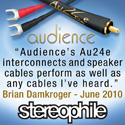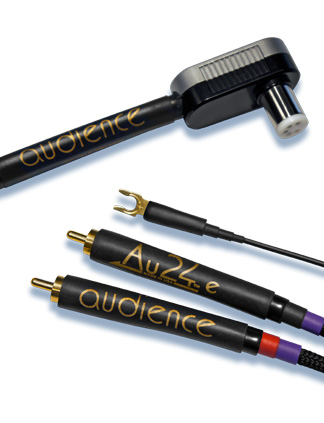|
|
You are reading the older HTML site
Positive Feedback ISSUE 61
audience Lo Z and Hi Z Phono Cables as reviewed by Roger S. Gordon
Where interconnect cables are concerned there seem to by two major groups of people - those who think all cables sound alike and those who think different cables sound different. Based on listening experiences I belong to the camp that believes different cables sound different and also that the same cables can sound different in different audio systems. This is the old "it worked in your system, why won't it work in mine" scenario. With regards to phono cables I always thought that phono cables were the same as interconnect cables. Thus, I bought the phono cables in my price range that to my ear rendered the greatest detail and transparency in my system. Over the years I have used a number of different phono cables. Currently, the phono cables that I use to connect my four tonearms to my phono stage were either supplied by the tonearm manufacturer themselves or I had the interconnects built for me by reputable manufacturers. I was very satisfied with the sound of my analog system and thought I would have to spend major dollars to make a significant improvement. I was wrong. Like most audiophiles I am a little obsessive. To get the best sound from my moving coil (MC) cartridges I would experiment with different loadings for each cartridge using resistor pairs of various values. Usually, but not always, the best sounding load was near the cartridge manufacturer's lowest loading suggestion; i.e. if the manufacturer's loading suggestion was "> 100 ohms" I would usually find the best sound to be around 100 ohms +/- 10%. Having experimentally found the best load for a cartridge I would have loading plugs made with the appropriate resistance. Using this methodology I was very happy with sound of my vinyl playback system. All this changed when I heard the Audience Lo Z and Hi Z phono cables in my system. The Audience Lo Z and Hi Z phono cables are designed to work with MC cartridges only. The Lo Z cables are designed for MC cartridges with internal impedance of less than 30 ohms, The Hi Z phono cables are designed for MC cartridges with internal impedance over 30 ohms.(1) Not being an engineer I was not sure what Lo Z (low impedance) and Hi Z (high impedance) really meant with respect to a MC cartridge. Happy in my ignorance I burned the Hi Z and Lo Z phono cables in on my Audiodharma cable cooker. After two days of cooking and then one day of rest I placed the Lo Z phono cables into my system connecting them to my Schroeder Reference tonearm with my Van den Hul Condor XGM. I put in the 487 ohm loading plugs that I normally use with the Condor and played an LP. The music did not sound right - it sounded like the loading was incorrect by a large amount. I then tried other pairs of loading plugs from 521 ohms to 10 ohms. None of the loading plugs improved the sound. Out of desperation I tried the 47k ohm loading plugs that had come with my Herron Audio VTPH-2 phono stage. On Keith Herron's suggestion I had tried using the 47k ohm loading plugs when I first got the Herron Phono stage. However, loading with the cartridge manufacturer's recommended minimum loading produced the best sound with the cables that I had. Now with the Lo Z cables and the loading at 47k ohms the sound was wonderful. I then tried the Lo Z cables on my VPI 12.5 with ZYX UNIverse S-SB cartridge and my Moerch DP-6 with Nakamichi MC-1000 cartridge. Instead of the usual 100 ohms, 47k ohms sounded the best on both of these tonearm/cartridge combinations. What was going on? I stopped my listening and started do research on the Web. It took a number of hours to find the answers to my questions. On Wikipedia I learned all about LC circuits, tank resonance, and RLC circuits. I found a short technical article by Jim Hagerman of Hagerman Tech: http://www.hagtech.com/loading.html. There was another short article that gave a diagram of the cartridge loading circuit: http://www.beavishifi.com/articles/Cartidge-Loading/. On the Audiogon forums I found some interesting discussions: http://forum.audiogon.com/4&5 (Start with jcarr on 12/12/09) and http://forum.audiogon.com18&4#18 (Start with jcarr on 8/14/10) In these discussions jcarr is Jonathan Carr the designer of Lyra cartridges and atmasphere is Ralph Karsten of Atma-Sphere maker of preamps with built-in phono stages and amps. From my readings I learned that by their inherent design all MC cartridges produce a very large frequency spike. The cartridge designer by his design moves this frequency spike out of the audible range. However, even though the listener can no longer hear this frequency spike it is still in the signal received by the phono stage. The design of some phono stages allows them to filter out this high frequency spike with no adverse consequences to the music. Other phono stages because of their design do react to this frequency spike which causes the phono stage to produce distortion (many times interpreted as a veiling of the music). Adding resistance (loading) to the phono stage inputs both damps (reduces the height) of the frequency spike and can also shift the center frequency of the spike. Thus, proper cartridge loading can eliminate this distortion by eliminating the frequency spike. Cartridge loading is therefore not done for the benefit of the cartridge but to keep the phono stage from misbehaving. With this knowledge I then did some experimentation. The amount of damping provide by loading the phono stage inputs is in inverse proportion to the number of ohms. Looking at the Beavis Hifi circuit diagram you can see that the loading resister connects the phono stage input directly to ground. The lower the value of the resistor the larger the amount of the cartridge signal that goes to ground and thus, does not enter the phono stage. Loading the input with 10 ohms provides very heavy damping; i.e. a lot of the current is going to ground and not entering the phono stage. Loading the input with 47k ohms provides very little damping; i.e. very little of the cartridge signal is going to ground and not entering the phono stage. No loading (infinity) means none of the current is going to ground and all of the signal is entering the preamp. My Ortofon Meister Silver MkII SPU cartridge sounded best with my old phono cables when loaded at 10 ohms (which was the manufacturer's minimum lowest loading amount; i.e. ">10 ohms". I played the Meister Silver with my old phono cables with 10 ohm loading and measured the sound pressure level of the music. I then switched to the Lo Z phono cables with 47k ohm loading and again measured the sound pressure level of the same music. The increase in the sound pressure level between the loading of 10 ohms and the loading of 47k ohms was over 4dB. A 4dB gain in sound pressure level corresponds to a 58% increase in the input voltage. Or in other words, the Meister Silver MkII with the Lo Z cable was essentially functioning near its stated .30mv output. With my old phono cable the Meister Silver MkII only had an output of approximately .19mv. This difference makes a huge difference in both macro and micro dynamics. With this knowledge I then proceeded to play five of my low impedance stereo MC cartridges on at least two different tonearms using 47k ohm loading and the Lo Z phono cables. The cartridges used and their manufacturer's recommended minimum loading were: ZYX UNIverse S-SB (100 ohms), Nakamichi MC-1000 (100 ohms), Miyajima Shilabe (200 ohms), Van den Hul Condor XGM MkII (200 ohms), and Ortofon Meister Silver MkII SPU (10 ohms). The tonearms used were: Moerch DP-6, VPI 12.5, Ortofon TA-210, and Schroeder Reference. In all of the 10 pairings, the Lo Z cable with 47k ohm loading was more dynamic and more transparent, to a greater or lesser extent, than what I had been able to achieve with my original cables and manufacturer's suggested loading. After this testing I then compared a combination of the Ortofon Meister Silver MkII on the Ortofon TA-210 tonearm using Ortofon's top-of-the-line phono cable (US$500) with 47k ohm loading against the same combination substituting the Lo Z cable for the Ortofon cable. The two cables sounded different, but I could not say that one was better than the other. I suspect that there is synergy in using the Ortofon phono cable with the Ortofon arm and cartridge. I then tested the Audience Hi Z phono cables. The only high impedance MC cartridge that I have is a Van den Hul Colibri XPW MkII. The manufacturer does not state the internal impedance but recommends loading > 500 ohms. With my old phono cables I found a loading of 521 ohms to yield the best sound. The rough rule of thumb in cartridge loading is that the loading should be 10 to 11 times the MC cartridge's internal impedance. Thus, the Colibri should have an internal impedance of about 47 to 50 ohms. In actuality, I suspect the Colibri's internal impedance is substantially lower than that. With the Colibri mounted on my Schroeder arm and using 47k loading I switched the Lo Z and Hi Z cables back and forth. There was a difference in sound, but it was not a large difference. I would say that the Hi Z cables were slightly more dynamic with a hint more transparency. Had the Colibri had a higher internal impedance I am sure the difference between the Lo Z and Hi Z cables would have been greater. I also tried the Hi Z cables with my ZYX UNIverse (4 ohms internal impedance) and Miyajima Shilabe (16 ohms internal impedance) cartridges on the VPI 12.5 arm at 47k ohms. These were not happy matches. The sound again sounded as if the loading was off by a considerable amount. So what is happening with the Audience Lo Z and Hi Z cables. First of all it is important to remember that the voltages coming from MC cartridges are very small. A typical CD player's output voltage is about 2.5v. A typical moving magnet/iron cartridge's output voltage is about .0025v and a low output MC cartridge's output voltage is typically .00025v or less. The .00025v coming from the MC cartridge is the A/C signal source driving an RLC circuit. R = resistance, L = inductance, C = capacitance The MC cartridge, itself, has impedance and inductance, though little capacitance. The cartridge's R and L combine with the R, L, and C of the headshell leads, the tonearm wires, and the phono cable plus the R of the loading resistor and the R of the input section of the phono stage, if any, to form an RLC circuit. If you do the calculations you will find that the voltage signal from the cartridge suffers less damage/attenuation if the R, L, and C are kept low. It is possible to make wires/cables that have low R, L, and C. However, keeping all three variables low costs more money than just keeping two of the variables low. Going back to Jim Hagerman's technical paper you will find the following sentences: "The super-low self-inductance of a moving coil cartridge puts them in their own category. At such levels, the loading capacitance becomes relatively insignificant, with system bandwidth now dominated by inductance and load resistance." Audience rather than going for a ‘price no object' (low R, low L and low C) solution has built their Lo Z cables to have low R and L and moderate C. This they feel yields a very good sounding phono cable at an affordable price. The Audience Hi Z phono cables keep only one variable low, C, and has moderate R and L. Regardless of the engineering merits of Audience's phono cable designs, the real question how is do the Lo Z and Hi Z phono cables actually perform? To answer that question I started to play my test LPs: Cypress 661-111-1 Famous Blue Raincoat, Jennifer Warnes, Bird on a Wire track Columbia FC 37152 Friday Night in San Francisco, Al Di Meola, John McLaughlin, and Paco de Lucia, side one, track one Island ILPS 9698 The Secret Policeman's Other Ball, side one, track one, Sting, Roxanne. Island 12 WIP 6598 The Secret Policeman's Ball, side one, track one, Peter Townshend, Pinball Wizard (acoustic guitar) DGC -24727 Unplugged in New York, Nirvana, About a Girl Warner Bros 25491-1 Trio, Dolly Parton, Li9nda Ronstadt, and Emmylou Harris, The Pain of Loving You Columbia OC 40158 Turbo, Judas Priest, Turbo Lover Classic Records 45rpm reissue Satchmo Plays King Oliver, Louis Armstrong, St. James Infirmary After listening to these tracks with the different combinations of tonearm and cartridge I came to the following conclusions: 1) The Audience cables are neutral sounding. They do not appear to color the sound in any appreciable way. 2) The audience cables are more transparent than the cables that I owned. This is what some people call "the lifting of the veils". Anyway, the Audience cables allowed me to hear more detail from the recordings than I had heard with my own cables. 3) With the Audience cables the music is more dynamic both on the macro and the micro scale. Attacks are sharper. Cymbal crashes are more startling. The music sounds more like what I hear in the concert hall. These increased dynamics could be caused in large part by the change to 47k ohm loading. However, without the Audience cables I could not use 47k ohm loading due to the R, L, and C characteristics of the cables that I have been using. Are there better phono cables out there than the Audience Lo and Hi Z phono cables? I do not know since I do not own a stable of top-of-the-line phono cables with which to do comparisons. However, I did consider the price/performance ratio of my own cables versus my perception of the price/performance ratio of the Lo Z and Hi Z phono cables. My conclusion was that the Audience Lo Z and Hi Z cables are not only excellent sounding phono cables but at their respective price points they are a bargain as well. If you have the chance, audition the Lo Z and Hi Z cables in your system and see if you can change your current loading to 47k ohms or higher. You may be pleasantly surprised by what you hear. As for me I am buying the Lo Z cable review sample and ordering two more as well. Highly recommended. Roger S. Gordon 1 meter pair with male RCAs at both ends:
Lo Z phono cables
Hi Z phono cables other lengths and terminations available
Audience (1) Audience is intending to bring out another phono cable designed for Moving Magnet/Iron cartridges. However, per John McDonald, president of Audience, the High Z cables should work with most moving magnet/moving iron cartridges if the phono stage itself does not add significant amounts of capacitance.
|









